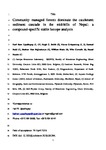Community managed forests dominate the catchment sediment cascade in the mid-hills of Nepal: A compound-specific stable isotope analysis.
| dc.contributor.author | Upadhayay, HR | |
| dc.contributor.author | Smith, HG | |
| dc.contributor.author | Griepentrog, M | |
| dc.contributor.author | Bodé, S | |
| dc.contributor.author | Bajracharya, RM | |
| dc.contributor.author | Blake, William | |
| dc.contributor.author | Cornelis, W | |
| dc.contributor.author | Boeckx, P | |
| dc.date.accessioned | 2018-06-11T09:01:54Z | |
| dc.date.issued | 2018-10-01 | |
| dc.identifier.issn | 0048-9697 | |
| dc.identifier.issn | 1879-1026 | |
| dc.identifier.uri | http://hdl.handle.net/10026.1/11634 | |
| dc.description.abstract |
Soil erosion by water is critical for soil, lake and reservoir degradation in the mid-hills of Nepal. Identification of the nature and relative contribution of sediment sources in rivers is important to mitigate water erosion within catchments and siltation problems in lakes and reservoirs. We estimated the relative contribution of land uses (i.e. sources) to suspended and streambed sediments in the Chitlang catchment using stable carbon isotope signature (δ13C) of long-chain fatty acids as a tracer input for MixSIAR, a Bayesian mixing model used to apportion sediment sources. Our findings reveal that the relative contribution of land uses varied between suspended and streambed sediment, but did not change over the monsoon period. Significant over- or under-prediction of source contributions could occur due to overlapping source tracer values, if source groups are classified on a catchment-wide basis. Therefore, we applied a novel deconvolutional framework of MixSIAR (D-MixSIAR) to improve source apportionment of suspended sediment collected at tributary confluences (i.e. sub-catchment level) and at the outlet of the entire catchment. The results indicated that the mixed forest was the dominant (41 ± 13%) contributor of sediment followed by broadleaf forest (15 ± 8%) at the catchment outlet during the pre-wet season, suggesting that forest disturbance as well as high rainfall and steep slopes interact for high sediment generation within the study catchment. Unpaved rural road tracks located on flat and steep slopes (11 ± 8 and 9 ± 7% respectively) almost equally contributed to the sediment. Importantly, agricultural terraces (upland and lowland) had minimal contribution (each <7%) confirming that proper terrace management and traditional irrigation systems played an important role in mitigating sediment generation and delivery. Source contributions had a small temporal, but large spatial, variation in the sediment cascade of Chitlang stream. D-MixSIAR provided significant improvement regarding spatially explicit sediment source apportionment within the entire catchment system. This information is essential to prioritize implementation measures to control erosion in community managed forests to reduce sediment loadings to Kulekhani hydropower reservoir. In conclusion, using compound-specific stable isotope (CSSI) tracers for sediment fingerprinting in combination with a deconvolutional Bayesian mixing model offers a versatile approach to deal with the large tracer variability within catchment land uses and thus to successfully apportion multiple sediment sources. | |
| dc.format.extent | 306-317 | |
| dc.format.medium | Print-Electronic | |
| dc.language | en | |
| dc.language.iso | en | |
| dc.publisher | Elsevier | |
| dc.subject | Compound-specific stable isotope (CSSI) analysis | |
| dc.subject | Deconvolutional approach | |
| dc.subject | Fatty acids | |
| dc.subject | Isotope mixing model | |
| dc.subject | MixSIAR | |
| dc.title | Community managed forests dominate the catchment sediment cascade in the mid-hills of Nepal: A compound-specific stable isotope analysis. | |
| dc.type | journal-article | |
| dc.type | Journal Article | |
| plymouth.author-url | https://www.ncbi.nlm.nih.gov/pubmed/29751311 | |
| plymouth.volume | 637-638 | |
| plymouth.publication-status | Published | |
| plymouth.journal | Science of the Total Environment | |
| dc.identifier.doi | 10.1016/j.scitotenv.2018.04.394 | |
| plymouth.organisational-group | /Plymouth | |
| plymouth.organisational-group | /Plymouth/Admin Group - REF | |
| plymouth.organisational-group | /Plymouth/Admin Group - REF/REF Admin Group - FoSE | |
| plymouth.organisational-group | /Plymouth/Faculty of Science and Engineering | |
| plymouth.organisational-group | /Plymouth/Faculty of Science and Engineering/School of Geography, Earth and Environmental Sciences | |
| plymouth.organisational-group | /Plymouth/REF 2021 Researchers by UoA | |
| plymouth.organisational-group | /Plymouth/REF 2021 Researchers by UoA/UoA14 Geography and Environmental Studies | |
| plymouth.organisational-group | /Plymouth/Research Groups | |
| plymouth.organisational-group | /Plymouth/Research Groups/Marine Institute | |
| plymouth.organisational-group | /Plymouth/Users by role | |
| plymouth.organisational-group | /Plymouth/Users by role/Academics | |
| plymouth.organisational-group | /Plymouth/Users by role/Researchers in ResearchFish submission | |
| dc.publisher.place | Netherlands | |
| dcterms.dateAccepted | 2018-04-29 | |
| dc.rights.embargodate | 2019-5-8 | |
| dc.identifier.eissn | 1879-1026 | |
| dc.rights.embargoperiod | No embargo | |
| rioxxterms.versionofrecord | 10.1016/j.scitotenv.2018.04.394 | |
| rioxxterms.licenseref.uri | http://www.rioxx.net/licenses/all-rights-reserved | |
| rioxxterms.licenseref.startdate | 2018-10-01 | |
| rioxxterms.type | Journal Article/Review |


